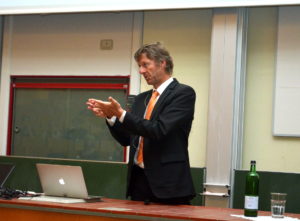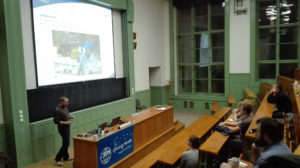 Prague EPS Young Minds section organized a large student meeting at the beginning of the winter semester. It took place at Czech Technical University in Prague in October.
Prague EPS Young Minds section organized a large student meeting at the beginning of the winter semester. It took place at Czech Technical University in Prague in October.
Our section organized event of this kind for the second time. At the beginning of the both meetings, invited speakers gave talk on contemporary and interesting topics. On the first meeting (april 2016), it was about gravitational waves, on the second one it was about the manned and unmanned flights to Mars, one of the most advertised space research activities. This topic was very attractive, thus there were attendance of approximately 50 students. Furthermore, attenders had chance to ask any questions on space research, thus the discussion after the presentation was long and very interesting.
Visitors could enjoy coffee, tea and some snacks, that made the ambience of the meeting very informal and friendly. After the talk, we prepared additional refreshments. This was a great opportunity for students to meet new people, or just to continue in discussion about flights to Mars.
This event was widely advertised. Large numbers of posters was distributed among several academic buildings in Prague. In addition, the information on meeting was spread on social sites of not only our Section, but also of other students´ groups in Prague. Before the talk started, we had presented our section and its future activities, to attract more students.
This event was again generally rated as a good idea. There is no doubt, that such an event is a unique opportunity to connect students of different age and from different universities, via an interesting multidiscipline contemporary presentation, that everybody is interested in.
Physics Pizza Party Season 3
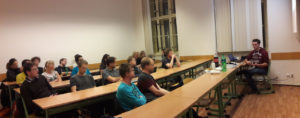 One of the main goals of EPS Young Minds project is to connect young scientists among different physics fields. Therefore, Prague section decided to organize students’ colloquiums named Physics Pizza Party: Students 4 students, where young scientists from different universities and research fields presented their research activities. These events prove to be very successful in winter semester in 2016.
One of the main goals of EPS Young Minds project is to connect young scientists among different physics fields. Therefore, Prague section decided to organize students’ colloquiums named Physics Pizza Party: Students 4 students, where young scientists from different universities and research fields presented their research activities. These events prove to be very successful in winter semester in 2016.
Totally, we organized four colloquiums this semester and for the first time half of the speakers were outside our parent faculty. We had one speaker from Faculty of Electrotechnics (Czech Technical University in Prague) and one from Faculty of Mathematics and Physics (Charles University in Prague). Various themes were presented as: study of solid materials using ultrasound and lasers, algorithms in gambling machines, presentation about superfluid helium and about proposed detector for planned particle collider – Future Circular Collider. All contributions were presented by Ph.D. and master students.
For most of invited speakers, it was their first experience to present their research activities in front of the audience which was not familiar with the topic. Despite of this fact, each talk was perfectly prepared, and therefore there was no problem to understand given topic. Each event was scheduled for about 60 minutes, but with discussion during and after presentation, average time of colloquiums was about 90 minutes and even more. According to the speakers it was very rewarding experience for them.
These events were advertised in form of posters, which were placed in school buildings. For the purpose of inviting as many participants as possible, we also advertised it on our social sites, namely Facebook and Twitter. Thanks to this advertisement, our students’ colloquiums had large attendance. Average number of participants was around 30 students per one colloquium.
The Prague EPS Young Minds Section found these colloquiums rewarding, since this style of presentation “students for students” is still very rare in our country and we were one of the first who organized this style of colloquiums. According to the feedback from our participants, we concluded that our colloquiums were successful, since they were very positively rated by participants. Thanks to these positive feedback and high number of participants, we would like to continue with this activity – this is what students in Prague expect as well.
Pizza Physics & Beer
The EPFL YM section was freshly and newly created. As targeted we could organize 3 ‘Pizza Physics Beer’ (PPB) seminars gathering from 20 to 30 people each time. The subjects we explored through these meetings covered nuclear fusion with a visit of the Tokamak reactor of EPFL, ultra hard materials which could be used for propellers and the hazards in nuclear reactor with an analysis of previous nuclear accident and the pertinence of the risk mitigation measures that were taken. This seminar serves now as the flagship event of our interactions within the Physics community at EPFL.
We also organized a visit to IBM Research in Zurich to participate to the event “Hack a Quantum Computer – Getting Involved with the IBM Quantum Experience“. It was the opportunity for us to meet with other EPS and YM members. It triggered the interaction of biophysicists, astrophysicists or condensed matter physicists from the campus around a common topic, namely the birth of quantum cloud computing. These first events made possible by the EPS grant are very encouraging and show us that we can make the EPFL physics community more vivid and interact more widely within the EPS community.
The physics of imperfect graphene
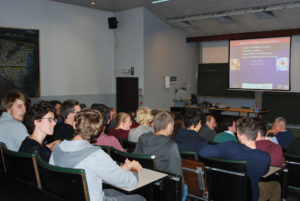 On the 29th of September 2016 the Antwerp Young Mind section invited Professor Doctor Eva Y. Andrei to give a colloquium at the University of Antwerp about her work on imperfect graphene. The target audience were the students and researchers of the University of Antwerp physics department, many of whom attended the lecture.
On the 29th of September 2016 the Antwerp Young Mind section invited Professor Doctor Eva Y. Andrei to give a colloquium at the University of Antwerp about her work on imperfect graphene. The target audience were the students and researchers of the University of Antwerp physics department, many of whom attended the lecture.
Professor Eva Andrei is an experimental condensed matter physicist at the Rutgers University in New Jersey, USA. Her research focuses on the electronic properties of graphene and other low dimensional materials and explores the effects of external perturbations on these types of systems. The experimental work done by her and her group led to several important discoveries, including the observation of the fractional quantum Hall effect in suspended graphene and the discovery of Van Hove singularities in twisted graphene layers. The speaker’s extensive experience and knowledge of these topics entitle her as an international authority on the subject of graphene.
Professor Andrei began her talk with a general introduction on the subject of graphene in order to make those who might not yet be familiar with this system acquainted with the topic. Subsequently, she focused on more specialized phenomena that emerge when the lattice of graphene is disrupted. In particular, she discussed her work on the effects of single atom vacancies on graphene’s electronic and magnetic properties. The colloquium as a whole was a great occasion for students to be introduced to the concepts of two-dimensional systems and graphene, while at the same time it provided the researchers of our department with a more profound overview of the theory and workings of imperfect graphene.
The lecture was followed by a reception, where the audience members and speaker could enjoy a drink and a bite. This also presented our students and researchers the opportunity to speak with professor Andrei in a more informal setting than the lecture itself.
Altogether, the colloquium was a great way for our university’s physics department to kick off the academic year.
Physico-chemical experiments on the core of a comet
In the first part of his talk he explained the preceding laboratory experiments on the formation and chemical composition of cosmic dust grains and their ice mantles. Using mass-spectrometry he found different organic molecules like amino acids formed in the laboratory comet by a photochemical reaction with UV-radiation as it is also likely to happen in space. Those molecules are interesting because of their occurrence in all Proteins and genetic information carriers such as DNA and RNA and proof of their existence on real comets might give a new view on the origin of live in our solar system.
The second part of the talk was a summary of the Rosetta mission and some of its difficulties. The Professor showed pictures of the comet taken by the orbiter and described the landing process of Philae, which was quite exciting. Finally he explained the onboard measurement configuration and the results of his experiments on the comet.
Before the talk we had a barbecue. In doing so we aimed to create an active exchange between the students of physics and of chemistry. After the talk we also gave interested guests the opportunity to get in contact with the referee.
All in all we were really glad about having Prof. Meierhenrich here at Jena and about having the possibility to hear about such an impressive project at first hand.
For more pictures you can wisit our webside:
Students 4 Students 2016
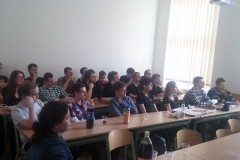 One of the main goals of EPS Young Minds project is to connect young scientists among different physics fields, and therefore Prague section decided to organize students’ colloquiums named Physics Pizza Party: Students 4 students, where young scientists from our university presented their research activities. These events prove to be very successful in winter semester of academic year 2015/2016.
One of the main goals of EPS Young Minds project is to connect young scientists among different physics fields, and therefore Prague section decided to organize students’ colloquiums named Physics Pizza Party: Students 4 students, where young scientists from our university presented their research activities. These events prove to be very successful in winter semester of academic year 2015/2016.
Totally, we organized four colloquiums this semester, with various themes: first colloquium was about more theoretical concept as a quantum entanglement, second about holograms, third colloquium give information about nuclear waste and storage methods of waste and the last colloquium presented modern methods of cancer treatment – cyberknife. All contributions were presented by Ph.D. and master students.
For most of invited speakers, it was their first experience to present their research activities in front of the the audience, which was not familiar with the topic. Despite of this fact, each talk was perfectly prepared, and therefore there was no problem to understand given topic. Each event was scheduled for about 60 minutes, but with discussion during and after presentation, average time of colloquiums was about 90 minutes and even more. According to the speakers it was very rewarding experience for them.
These events were advertised in form of posters, which were placed in school buildings. For the purpose of inviting as many participants as possible, we also advertised it on our social sites, namely Facebook and Twitter. Thanks to this advertisement, our students’ colloquiums were most visited. Average number of participants was around 20 students per one colloquium.
The Prague EPS Young Minds Section found these colloquiums rewarding, since this style of presentation “students for students” is still very rare in our country and we were one of the first, who organized this style of colloquiums. According to the feedback from our participants, we concluded, that our colloquiums were successful, since they were very positively rated by participants. Thanks to these positive feedback and high number of participants, we would like to continue with this activity.
[nggallery id=104]
7th Czechoslovak Science Students Conference and FNSPE Students
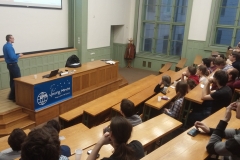 Prague EPS Young Minds section organized two large student meetings during the last few months. Both of them took place at Czech Technical University in Prague, first of them in April and the other one in May.
Prague EPS Young Minds section organized two large student meetings during the last few months. Both of them took place at Czech Technical University in Prague, first of them in April and the other one in May.
The first one was Start of the Semester Party. Well-organized advertisement of this event across Prague universities resulted in attendance of approximately 60 students. At the beginning, invited speaker gave the interesting talk about the gravitational waves, one of the newest and very important science discoveries. After a long and passionate discussion, all of the students attending the presentation were invited for the evening buffet, that lasted till the late-night hours. This event was generally rated as a good idea to connect students via interesting multidiscipline and actual presentation, and it is demanded to be organized in future.
Czechoslovak Science Students Conference is meeting of university students, when they have great opportunity to present their physical research and meet their colleagues. This conference is organized each year alternately in Slovakia and Czech Republic. This year, 60 students from these countries met at Czech Technical University in Prague. During the first day, students could attend several excursions in laboratories in Prague. At the evening, they were invited to a ceremonial dinner. After this dinner, we presented Young Minds project and our activities, then students could watch movie “Particle fever”, owned by our section. The second day of conference was dedicated for presentations in 6 sections, each supervised by its jury. At the end of the conference, students with the best presentations were granted a prize. Prague EPS Young Minds section collaborated with Faculty of Nuclear Sciences and Physical engineering on organization of this conference. Particularly, we organized all of the activities during the first day of this international meeting. The second day, we arranged coffee breaks and helped with technical issues of the conference. Our contribution on organization of this event was highly appreciated.
[nggallery id=105]
Posters
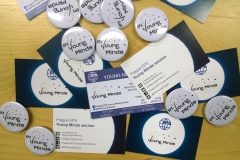 Prague section of EPS Young Minds project is the first one in the Czech Republic. It is not connected with any other group or local project. That is why it is needed, that as many people as possible recognize it and are informed about our goals and activities.
Prague section of EPS Young Minds project is the first one in the Czech Republic. It is not connected with any other group or local project. That is why it is needed, that as many people as possible recognize it and are informed about our goals and activities.
In these days, there many possibilities to promote activities and we try to exploit all of them. We would like to make good image to the name of “Young Minds”, so that every student is familiar with our main goals and style of our activities. That is why we decided to also prepare big posters, badges and business cards that were distributed to all people visiting our events, or to those, that could be future participants in our events.
Badges are very popular promotional object in these days. You can just pin them to your bag or jacket, and then everybody who see it knows, that you are interested in promoted activity. Layout of our Young Minds badge is simple – we just redesigned Young Minds logo. By having it on these badges, YM logo is being more and more known. Some people are asking about this logo, and consequently about the Young Minds project itself. We produced 50 badges, every YM member is obliged to have it on and we also distributed it in our events.
Lot of young students are not used to write down email addresses or another contact, they just hope to remember it. That is one of reasons why we designed business cards with information about our section. These are also more useful for face-to-face discussions about our activities. First bunch containing 40 low quality business card was distributed in one week that is why we decided to redesign them to be as attractive as possible and to print them in better quality. Fifty of them was produced, and we are distributing them every time it is needed.
These two mentioned manners are kind of active advertising, but we also produced the passive one. It is a big poster that is situated in hall of our faculty. It contains basic information about the goals not only of the Young Minds project, but also the EPS and the Czech Union of Mathematicians and Physicists. Our plan is to produce another type with short opinions of our members about becoming an active member of YM.
These object helped us with spreading idea of Young Minds.
[nggallery id=69]
Reunión Nacional de Óptica Joven, RNOJ (Young Optics Spanish Meeting)
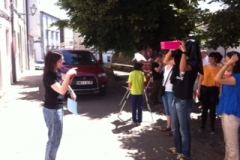 One of the most important national meetings is the RNO (Reunión Nacional de Óptical) that was held in Salamanca. Due to our work as PhD Students, this meeting is a great opportunity to meet other YM Section and to perform some activities and improve our social network.
One of the most important national meetings is the RNO (Reunión Nacional de Óptical) that was held in Salamanca. Due to our work as PhD Students, this meeting is a great opportunity to meet other YM Section and to perform some activities and improve our social network.
In this case the Student Chapter from Salamanca proposed an outdoor activity during the afternoon. In this case the proposal was to make some experiments in one of the major squares in Salamanca. In our case, the proposal was to bring some of our material from Santiago and make one of the experiments we usually make. In this case we propose the performance of some activites we make in a local festival in Santiago (“Festa da Primavera”). We brought material like our Tindall Experiment or our portable black camera.
Moreover the outreach performed by the different student groups, the RNOJ was a good possibility to exchange our feelings about optics, our YM activities and the improvement of our social connections.
This activity is important to make strong connections and to make new collaborations between the groups. As an example we talked with the YM Section from Valladolid and with the OSA Student Chapter from Salamanca about to make some activities in the St. James Way. In this case we need to make efforts if we want to make possible this kind of huge purposes, however we think that it is a significant example about how important are this kind of meetings between the young researchers and their Students groups.
Optical Workshop
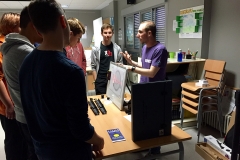 Each year University Jaume I (UJI) of Castellón celebrates the days of dissemination called “Connecta amb la Ciència” (means “Connect with the Science”). These days have the objective of publicize the courses and degrees offered by the scientific area of the UJI. People (teachers, postdocs, students…) working in several areas from the university go to many places around the region of Castellón and offer workshops about chemistry, videogames, optics and photonics, renewable energies, etc. and many high school students attend these workshops.
Each year University Jaume I (UJI) of Castellón celebrates the days of dissemination called “Connecta amb la Ciència” (means “Connect with the Science”). These days have the objective of publicize the courses and degrees offered by the scientific area of the UJI. People (teachers, postdocs, students…) working in several areas from the university go to many places around the region of Castellón and offer workshops about chemistry, videogames, optics and photonics, renewable energies, etc. and many high school students attend these workshops.
Taking advantage of the conference “Connecta amb la Ciència” the GOC members have travelled through different towns of the province to bring science to high school students.
We have prepared several micro workshops to show different physical properties and concepts related to optics (atmospheric scattering, refraction, diffraction on a CD, light absorption, polarization…) and also explain how works the human eye. In this way, students from all region have the opportunity to learn science by having fun.
We showed these workshops in 2014 and teachers from different high schools requested our workshops also for this year 2015 because the students enjoyed them. This year we have only visited the Puerto de Sagunto town (last 2nd March) and a high school near to the university (last 22nd April). However we have already planned visiting Morella (23rd October), Vinaroz (26th October), Sagunto (9th November), and Vila-Real (16th November). We have some new material for improve our explanations, so we hope students learn more and enjoy very much!

